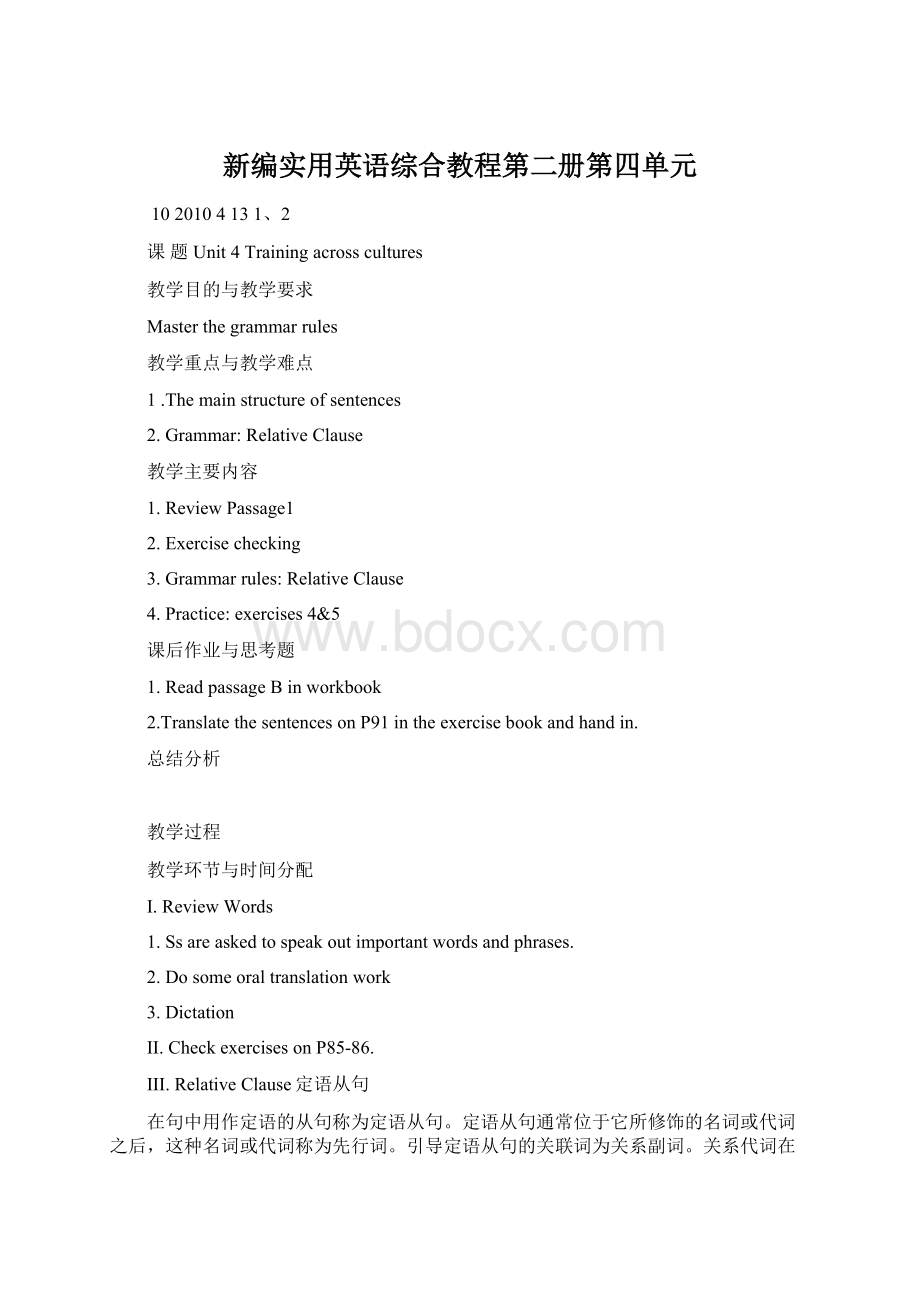新编实用英语综合教程第二册第四单元.docx
《新编实用英语综合教程第二册第四单元.docx》由会员分享,可在线阅读,更多相关《新编实用英语综合教程第二册第四单元.docx(13页珍藏版)》请在冰豆网上搜索。

新编实用英语综合教程第二册第四单元
1020104131、2
课题Unit4Trainingacrosscultures
教学目的与教学要求
Masterthegrammarrules
教学重点与教学难点
1.Themainstructureofsentences
2.Grammar:
RelativeClause
教学主要内容
1.ReviewPassage1
2.Exercisechecking
3.Grammarrules:
RelativeClause
4.Practice:
exercises4&5
课后作业与思考题
1.ReadpassageBinworkbook
2.TranslatethesentencesonP91intheexercisebookandhandin.
总结分析
教学过程
教学环节与时间分配
I.ReviewWords
1.Ssareaskedtospeakoutimportantwordsandphrases.
2.Dosomeoraltranslationwork
3.Dictation
II.CheckexercisesonP85-86.
III.RelativeClause定语从句
在句中用作定语的从句称为定语从句。
定语从句通常位于它所修饰的名词或代词之后,这种名词或代词称为先行词。
引导定语从句的关联词为关系副词。
关系代词在定语从句中可用作主语、宾语、表语、介词宾语和定语等,关系副词在定语从句中只用作状语。
1.由关系代词who,whom,whose,which,that引导的定语从句
1)who代替人,在从句中作主语。
Amanwhodoesnottrytolearnfromotherscannothopetoachievemuch.
一个不向别人学习的人是不能指望有多大成就的。
2)whom代替人,在从句中作宾语,通常可省略。
Theengineerswhomwemetyesterdayhaveworkedoutanewautomaticdevice.
我们昨天碰到的那些工程师设计出了一种新的自动化装置。
3)whose代替人或物,在从句中作定语。
MadameCurieisagreatscientistwhosenameisknownallovertheworld.
居里夫人是一位全世界闻名的伟大科学家。
(指人)
Theyliveinthehousewhosedoorandwindowsareallbroken.
他们所居住的房子门窗都坏了。
(指物)
4)which代替物,在从句中作主语、宾语或介词宾语。
作宾语时,通常可省略。
Adirectcurrentisacurrentwhichflowsinonedirectiononly.
直流电是沿着一个方向流动的电流。
Themusictowhichwelistenedlastnightwaswrittenbymyfather.
我们昨晚听的那首曲子是我父亲写的。
HeistheonlyoneamongusthatknowsEnglish.
5)that代替人或物,在从句中作主语或宾语,但不能作介词宾语。
作宾语时通常可省略。
他是我们当中唯一懂英语的人。
(指人)
ThecarthatalmostcrashedintomebelongedtoBrown.
差点撞上我的那辆车是布朗先生的。
(指物)
Shetalkedabouttheprofessorsandcollegesthatshehadvisited.
她谈到了她所访问过的教授和大学。
(指人和物)
注意:
关系代词that和which的区别如下:
1)先行词为all,anything,something,nothing,everything,little,much等不定代词时,只能用that。
Matterisanythingthathasweightandtakesupspace.
任何具有重量并占有空间的东西都是物质。
2)先行词前有最高级形容词以及first,last,every,some,any,very,next,only等修饰词时,只能用that。
Thefirstthingthattheyshoulddoistoworkouttheirplan.
他们该做的第一件事就是制定个计划。
3)which引导的定语从句前可使用逗号,表示这是非限定性定语从句,that从句则不能。
Hisspeech,whichboredeveryone,wentonandon.
他的演讲不断持续着,令每一个人都心烦。
InevermetJudyagain,whichwasapity.
我再也没见到朱迪,十分遗憾。
ThecarthatalmostcrashedintomebelongedtoBrown.
差点撞上我的那辆车是布朗先生的。
(指物)
Shetalkedabouttheprofessorsandcollegesthatshehadvisited.
她谈到了她所访问过的教授和大学。
(指人和物)
ThecarthatalmostcrashedintomebelongedtoBrown.
差点撞上我的那辆车是布朗先生的。
(指物)
Shetalkedabouttheprofessorsandcollegesthatshehadvisited.
她谈到了她所访问过的教授和大学。
(指人和物)
ThecarthatalmostcrashedintomebelongedtoBrown.
差点撞上我的那辆车是布朗先生的。
(指物)
Shetalkedabouttheprofessorsandcollegesthatshehadvisited.
她谈到了她所访问过的教授和大学。
(指人和物)
注意:
关系代词that和which的区别如下:
1)先行词为all,anything,something,nothing,everything,little,much等不定代词时,只能用that。
Matterisanythingthathasweightandtakesupspace.
任何具有重量并占有空间的东西都是物质。
2)先行词前有最高级形容词以及first,last,every,some,any,very,next,only等修饰词时,只能用that。
Thefirstthingthattheyshoulddoistoworkouttheirplan.
他们该做的第一件事就是制定个计划。
3)which引导的定语从句前可使用逗号,表示这是非限定性定语从句,that从句则不能。
Hisspeech,whichboredeveryone,wentonandon.
他的演讲不断持续着,令每一个人都心烦。
InevermetJudyagain,whichwasapity.
我再也没见到朱迪,十分遗憾。
2.由关系副词when,where,why所引导的定语从句
1)when作状语,其先行词多为表示时间概念的名词。
WecanneverforgetthedaywhenHongKongreturnedtoourhomeland.
我们永远不会忘记香港回归祖国的那一天。
2)where作状语,其先行词多为表示地点概念的名词。
Thebuildingwhereyouusedtolivehasbeenpulleddown.
你过去曾的住过的那栋大厦已经被拆除了。
3)why作状语,其先行词多为表示原因概念的名词。
Weknowthereasonwhyhewasveryangry.
我们知道他为什么非常生气。
3.限制性定语从句与非限制性定语从句
1)限制性定语从句
通常限制性定语从句与先行词关系密切,因此不能缺少,否则会影响全句的意义;从句前不用逗号。
Youcan’tanswerthequestionwhichheputforward.
你们回答不了他所提出的问题。
2)非限制性定语从句
非限制性定语从句与先行词只是一种松散的修饰关系,一般只是补充其意思,即使省略了也不会影响主句意义的完整性;从句前常用逗号分开,从句中的关系代词不能省略。
Helenwasmuchkindertoheryoungestchildthanshewastotheothers,which,ofcourse,madeothersjealous.
海伦对最小的孩子比对别的孩子体贴得多,这当然使得别的孩子妒忌。
IV.Practice
1.Doexercises4&5(onP90-91)
2.Checktheanswers
V.Homework
1.ReadpassageBinworkbook
2.TranslatethesentencesonP91intheexercisebookandhandin.
1120104201、2
课题Unit4Beingallearsandtryingyourhands
教学目的与教学要求
1.Understandtheexpressionsofshopping.
2.Readthedialoguesandimitatetomakedialogues.
3.Practicelistening.
4.Introducesomelisteningskills.
教学重点与教学难点
1.Makeconversationswithothersbasedonshopping.
2.Usefulexpressionsandpatternsforshopping.
3.Listeningandjudgement.
4.Passagelistening.
教学主要内容
2.Beingallears
2.1ListenandDecode.
2.2ListenandRespond.
课后作业与思考题
1.Chooseonesituationtomakeupadialogueintheworkbook.
2.FinishExercise1,2,3onP107-108inthetextbook.
3.FinishExercise4,5inSectionIV(P109)inthetextbook.
4.FinishExerciseBinSection4intheworkbook.
总结分析
教学过程
教学环节与时间分配
I.leadingin
AskSswhattheyliked